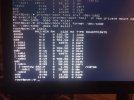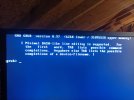Hello everyone, I am trying to install proxmox on an HP DL380p gen8 server with more or less success. I managed to find out that it is necessary to switch the raid card (p420i) to HBA mode and I found that because of this I have to create an external drive from which proxmox will boot. The problem I have is that I can't do this USB, even if I follow the different descriptions, it doesn't work. (https://www.reddit.com/r/Proxmox/comments/ph1q5h/proxmox_install_on_nonbootable_disks_hp_dl_380p/)
The USB on which I currently want to put the boot files is called the sdd drive (I am attaching a picture). I tried to create the partitions with gdisk, but if I made them efi or gpt or maybe mbr, the proxmox boot tool did not see them. So, if I may ask, could someone write a foolproof description of how to make such a USB?
The USB on which I currently want to put the boot files is called the sdd drive (I am attaching a picture). I tried to create the partitions with gdisk, but if I made them efi or gpt or maybe mbr, the proxmox boot tool did not see them. So, if I may ask, could someone write a foolproof description of how to make such a USB?







